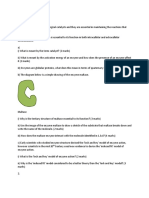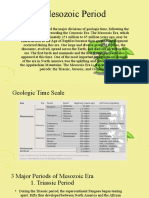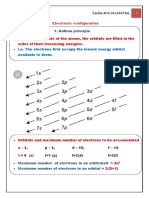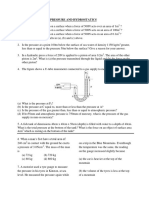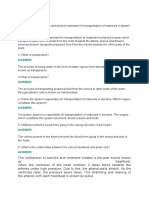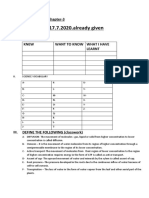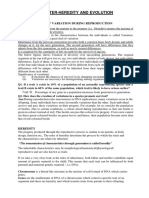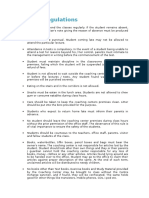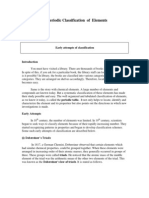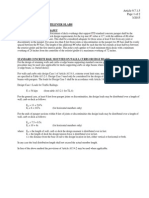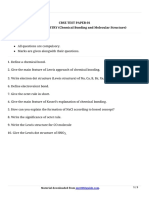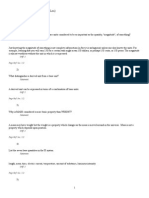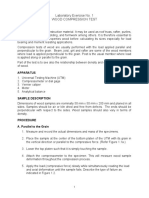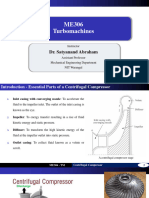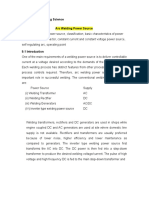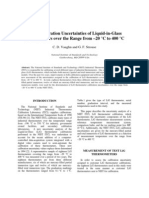0 ratings0% found this document useful (0 votes)
68 viewsGravitation Newton'S Law of Gravitation
Gravitation Newton'S Law of Gravitation
Uploaded by
not atall1. Newton's universal law of gravitation states that every particle in the universe attracts every other particle with a force proportional to the product of their masses and inversely proportional to the square of the distance between them.
2. The gravitational force of attraction between two bodies is directly proportional to the product of their masses and inversely proportional to the square of the distance between their centers.
3. Mass is a measure of the amount of matter in a body, while weight is the gravitational force exerted on a mass by another massive body like the Earth. Weight depends on location but mass does not.
Copyright:
© All Rights Reserved
Available Formats
Download as PDF, TXT or read online from Scribd
Gravitation Newton'S Law of Gravitation
Gravitation Newton'S Law of Gravitation
Uploaded by
not atall0 ratings0% found this document useful (0 votes)
68 views3 pages1. Newton's universal law of gravitation states that every particle in the universe attracts every other particle with a force proportional to the product of their masses and inversely proportional to the square of the distance between them.
2. The gravitational force of attraction between two bodies is directly proportional to the product of their masses and inversely proportional to the square of the distance between their centers.
3. Mass is a measure of the amount of matter in a body, while weight is the gravitational force exerted on a mass by another massive body like the Earth. Weight depends on location but mass does not.
Original Description:
Gravitation Notes
Original Title
Gravitation Notes
Copyright
© © All Rights Reserved
Available Formats
PDF, TXT or read online from Scribd
Share this document
Did you find this document useful?
Is this content inappropriate?
1. Newton's universal law of gravitation states that every particle in the universe attracts every other particle with a force proportional to the product of their masses and inversely proportional to the square of the distance between them.
2. The gravitational force of attraction between two bodies is directly proportional to the product of their masses and inversely proportional to the square of the distance between their centers.
3. Mass is a measure of the amount of matter in a body, while weight is the gravitational force exerted on a mass by another massive body like the Earth. Weight depends on location but mass does not.
Copyright:
© All Rights Reserved
Available Formats
Download as PDF, TXT or read online from Scribd
Download as pdf or txt
0 ratings0% found this document useful (0 votes)
68 views3 pagesGravitation Newton'S Law of Gravitation
Gravitation Newton'S Law of Gravitation
Uploaded by
not atall1. Newton's universal law of gravitation states that every particle in the universe attracts every other particle with a force proportional to the product of their masses and inversely proportional to the square of the distance between them.
2. The gravitational force of attraction between two bodies is directly proportional to the product of their masses and inversely proportional to the square of the distance between their centers.
3. Mass is a measure of the amount of matter in a body, while weight is the gravitational force exerted on a mass by another massive body like the Earth. Weight depends on location but mass does not.
Copyright:
© All Rights Reserved
Available Formats
Download as PDF, TXT or read online from Scribd
Download as pdf or txt
You are on page 1of 3
GRAVITATION
NEWTON’S LAW OF GRAVITATION
Everybody in this universe attracts every other body with a force which is directly proportional to the product of their
masses and inversely proportional to the square of the distance between their centres.
The direction of the force is along the line joining the centres of the bodies and is always a vector.
Consider two bodies A and B of masses m1 and m2
respectively, such that d is the distance between their
centres.
<---------------d--------------> Let F be the force by which these bodies mutually attract
each other.
Then according to Newton,
F α m1 m2 ----------------(1)
2
F α 1/d -------------------(2)
Combining equation (1) and (2) we get
2
F α (m1 m2 ) / d
F = G m1 m2 / d2
Where G – Constant of proportionality called Gravitational
-11 2 -2
constant. G = 6.67 x 10 Nm kg .
Importance of the universal law of gravitation
1. The gravitational force of attraction of the earth is responsible for binding all terrestrial objects on the earth.
2. The gravitational force of earth is responsible for holding the atmosphere around the earth.
3. The gravitational force of the earth is also responsible for the rainfall and snowfall on the earth.
4. The tides formed by the rising and falling of water level in the ocean are due to the gravitational force of attraction ,
which the sun and the moon exert on sea water.
Gravity
It is the force of attraction between the earth and any object lying on or near its surface. A body thrown up falls back on
the surface of the earth due to earth’s force of gravity.
Relationship between the acceleration due to gravity and the force of attraction.
Let m – mass of the body
M – mass of the earth
R – radius of the earth
g - acceleration due to gravity
F – Force acting on the body
By the Newton’s second law of motion
F = mg ------------(1)
From Newton’s law of gravitation
2
F = GmM / R ------(2)
Comparing equation (1) and (2)
2
mg = GmM / R
g = GM / R2
-11 24 6 2
g = 6.67 x 10 x 6 x 10 / ( 6.4 x 10 )
-2
g = 9.8 ms .
Note
1. g moon = (1/6) g earth
2. As the polar radius of the earth is smaller than the equatorial radius, therefore , the acceleration due to gravity on
poles is more than that at the equator.
3. To move to higher altitudes or go deep inside the earth, its value always decreases. It becomes zero at the centre of
the earth.
Mass
The amount of matter contained in a body is called the mass.
Unit ( In SI system) - kg.
Inertial Mass
When we apply force on a body , it moves with a certain acceleration. The ratio between the applied force and
acceleration produced is called inertial mass.
F/ a = mi Where mi – inertial mass , F – force applied on a body, a - acceleration.
Gravitational mass
When a body falls towards the earth with acceleration due to gravity, it experiences a gravitational force.
The ratio between the gravitational force on the earth on a given body to the acceleration due to gravity is called the
gravitational mass.
mG = F/g where F – Force of gravitation due to earth on a given body, g - acceleration due to gravity,
mG – gravitational mass.
It is useful to note that the magnitude of the gravitational mass and the inertial mass at a given place is the same.
To show that if to bodies are attracted by the earth with the same force, then they have equal masses.
Consider two bodies A and B , such that their masses are m1 and m2 . Let both the bodies be attracted by the earth with
the same force F.
M – mass of earth
R – radius of earth
2
For body A , F = Gm1M / R -------------- (1)
2
For body B , F = Gm2M / R -------------- (2)
Comparing equation (1) and (2)
2 2
Gm1M / R = Gm2M / R
m1 = m2
Thus , when two bodies are attracted with the same force at a given place, they have equal masses.
Weight
The force with which a body falls towards the surface of earth, is called its weight.
(OR)
The pull exerted on a body by the earth is called its weight.
F = mg where, F – force with which the body is pulled towards the earth, m – mass of the body ,
g – acceleration due to gravity.
Weight of a substance is the product of its mass and acceleration due to gravity.
SI unit – newton
2
Gravitational unit – 1 kg-wt = 1 kg x 9.8 m/s = 9.8 N
Difference between mass and weight
S.No Mass Weight
1 Mass is the quantity of matter contained in a body and Weight of the body is the force with which the earth
is measure of its inertia. attracts the body.
2 It is a scalar quantity It is a vector quantity
3 Its value remains constant at all places,. i.e. does not It is a variable quantity and changes with the change in
change from place to place. acceleration due to gravity of a place.
4 Mass of a body can never be zero Weight of a body can be zero during free fall
5 It is measured by using a physical balance. It is measured by using a spring balance.
6 Its SI unit is kg. Its SI unit is newton.
Weightlessness
Weightlessness is a situation in which the effective weight of the body becomes zero.
The body can be in a weightlessness state in the following circumstances.
(i) When the body is taken at the centre of the earth.
(ii) When the body is taken at null points ( i.e. those points where the gravitational force due to different masses cancel out)
(iii) When a body is lying in a freely falling lift.
(iv) When the body is inside a space craft or satellite which is orbiting around the earth.
Motion equations for freely falling bodies and numerical problems
All freely falling bodies develop uniform acceleration due to gravity
S.No. General equations of motion Motion equations for the freely falling bodies
1 v = u + at v = u + gt
2 2
2 s = ut + ½ at h = ut + ½ gt
2 2 2 2
3 v – u =2as v – u =2gh
Following points must be kept in mind while solving numerical problems on freely falling bodies
-2
1. Acceleration due to gravity ‘g’ is positive and its value is 9.8 ms , when a body falls downwards.
-2
2. Acceleration due to gravity ‘g’ is negative and its value is -9.8 ms , when a body falls upwards.
3. When a body is dropped from a certain height, its initial velocity is zero.
4. When a body is projected vertically upward, its final velocity is zero (at highest point).
You might also like
- Mitosis Meiosis NotesDocument7 pagesMitosis Meiosis NotesSophia Cook100% (1)
- Enzymes AnsweredDocument3 pagesEnzymes Answeredyep okNo ratings yet
- Process Modelling and Simulation - IntroductionDocument40 pagesProcess Modelling and Simulation - Introductiondppriya1984100% (5)
- Method of Heat TransferDocument2 pagesMethod of Heat TransferNikki LorraineNo ratings yet
- Rocks Geography Study Material NotesDocument3 pagesRocks Geography Study Material NotesSTEPHEN AOCKIAM MNo ratings yet
- 07 Metamorphic RocksDocument17 pages07 Metamorphic Rocksjcasafranca0% (1)
- Physics SPM DefinitionsDocument7 pagesPhysics SPM DefinitionsJikoseNo ratings yet
- MesozoicDocument11 pagesMesozoicGelo LibeloNo ratings yet
- Electronic ConfigurationDocument11 pagesElectronic ConfigurationAnishaNo ratings yet
- GravitationDocument19 pagesGravitationkulnixNo ratings yet
- B2 Movement in & Out of CellsDocument20 pagesB2 Movement in & Out of CellsHai Anh LeNo ratings yet
- Electricity and Its Heating and Chemical EffectsDocument7 pagesElectricity and Its Heating and Chemical EffectsManish Kedawat50% (2)
- Pressure and Hydraulics WorksheetDocument2 pagesPressure and Hydraulics WorksheetEsther SparksNo ratings yet
- Chapter 7 & 8 Chem Study GuideDocument3 pagesChapter 7 & 8 Chem Study GuideseabreezeNo ratings yet
- Earth's LayersDocument3 pagesEarth's Layersreignman2000No ratings yet
- IGCSE BIOLOGY Disease Transmission QuestionsDocument3 pagesIGCSE BIOLOGY Disease Transmission Questionsngole_96No ratings yet
- Chapter 8-Transport in PlantsDocument33 pagesChapter 8-Transport in PlantsrinaahwNo ratings yet
- Transportation of Materials in Plants and Animals Question and AnswersDocument5 pagesTransportation of Materials in Plants and Animals Question and AnswersKunal SumukNo ratings yet
- Biology - Blood and Defence Against Disease (Part 1)Document13 pagesBiology - Blood and Defence Against Disease (Part 1)christineNo ratings yet
- Chapter 3 Lecture Notes Transmission Basics KTDocument24 pagesChapter 3 Lecture Notes Transmission Basics KTKealeboga Duece ThoboloNo ratings yet
- Atomic StructureDocument57 pagesAtomic StructureMary Rose JasminNo ratings yet
- Reflection of Light Printed Notes Class 8Document13 pagesReflection of Light Printed Notes Class 8Typist VBCNo ratings yet
- 9.1 Transport in Xylem of PlantsDocument15 pages9.1 Transport in Xylem of PlantsJason Charles100% (1)
- IX - InTSO - Worksheet - 1 (Atoms & Molecules)Document3 pagesIX - InTSO - Worksheet - 1 (Atoms & Molecules)arush0156No ratings yet
- Rajkumar Biology Printable Notes Unit 2 by Rajat.21-37Document17 pagesRajkumar Biology Printable Notes Unit 2 by Rajat.21-37Michael Benton100% (1)
- Matter in Our SurroundingsDocument7 pagesMatter in Our Surroundingsvivek_theeasyways100% (1)
- 14thermal Expansion of Materials - 227-249Document11 pages14thermal Expansion of Materials - 227-249KAMAL KANT KUSHWAHANo ratings yet
- Bahria Foundation Colleges (North) Centralized Notes of Short Questions (F.B.I.S.E) Physics SSC-IDocument63 pagesBahria Foundation Colleges (North) Centralized Notes of Short Questions (F.B.I.S.E) Physics SSC-IZaheer AhmedNo ratings yet
- Life Cycle of A BeeDocument2 pagesLife Cycle of A BeeDerassiNo ratings yet
- 1.2.3 Transport in PlantsDocument11 pages1.2.3 Transport in PlantsMo_Bash1No ratings yet
- Y10 Plant Transport Lesson 1Document27 pagesY10 Plant Transport Lesson 1Sherry LeeNo ratings yet
- Solubility CurvesDocument37 pagesSolubility Curvesapi-298247873100% (1)
- HabitatDocument4 pagesHabitatEman Fatima GulnawazNo ratings yet
- Mushroom Production Juncao Ottilia Final - AGRITEXDocument21 pagesMushroom Production Juncao Ottilia Final - AGRITEXChary Johanne MenesesNo ratings yet
- Chemical Bonding and Mot SynopsisDocument21 pagesChemical Bonding and Mot Synopsispochireddy revathiNo ratings yet
- NTSE Motion ResonanceDocument45 pagesNTSE Motion ResonanceNaman KumarNo ratings yet
- Structure of GametesDocument4 pagesStructure of Gametesapi-481318101No ratings yet
- Topic 5 - Energy Flow and Nutrient CyclingDocument2 pagesTopic 5 - Energy Flow and Nutrient Cyclingashley bedassieNo ratings yet
- Genetics and Heredity BiologyDocument7 pagesGenetics and Heredity BiologyMUDASIR REHMANNo ratings yet
- Created by C. Mani, Principal, K V No.1, AFS, Jalahalli West, BangaloreDocument21 pagesCreated by C. Mani, Principal, K V No.1, AFS, Jalahalli West, BangaloreAnaya SajilalNo ratings yet
- Grade-8-Transport in PlantsDocument6 pagesGrade-8-Transport in Plantsrengarajan82No ratings yet
- Heredity and Evolution: Accumulation of Variation During ReproductionDocument15 pagesHeredity and Evolution: Accumulation of Variation During ReproductionPundir DeeptiNo ratings yet
- RulesDocument2 pagesRulesMCHNo ratings yet
- Evolution, Merits and Demerits of Five Kingdom SystemDocument3 pagesEvolution, Merits and Demerits of Five Kingdom SystemDr A.K. VermaNo ratings yet
- Surface Chemistry Theory - EDocument26 pagesSurface Chemistry Theory - Ethinkiit100% (1)
- Magnetism Notes FinalDocument29 pagesMagnetism Notes FinalMuryum SalmanNo ratings yet
- Empirical Formula and Molecular Formulas 1Document23 pagesEmpirical Formula and Molecular Formulas 1gunapalshetty100% (1)
- Movement in and Out of The Cells (Diffusion, Osmosis)Document12 pagesMovement in and Out of The Cells (Diffusion, Osmosis)Mentari Ulfah100% (1)
- Class 5 EM Model Question PaperDocument9 pagesClass 5 EM Model Question PaperManjusha67% (3)
- About Phenol:: 2. Hydrolysis ofDocument3 pagesAbout Phenol:: 2. Hydrolysis ofNazmul NayeemNo ratings yet
- Periodic Classification of ElementsDocument33 pagesPeriodic Classification of ElementsHarsh GuptaNo ratings yet
- Ecosystem: Department of Environmental Science, Pub Kamrup CollegeDocument8 pagesEcosystem: Department of Environmental Science, Pub Kamrup CollegeDebajit SarmaNo ratings yet
- Mass Weight DensityDocument29 pagesMass Weight DensityKoh Seok HweeNo ratings yet
- Haber Process and AmmoniaDocument2 pagesHaber Process and AmmoniaAaron HongNo ratings yet
- ForceDocument26 pagesForceShinji100% (1)
- Classification of ElementsDocument1 pageClassification of Elementsdan964No ratings yet
- Units and Measurements CH2Document57 pagesUnits and Measurements CH2Rishab SharmaNo ratings yet
- Qu Sheet - GCSE - The Electric Bell - Qu & Answers PDFDocument2 pagesQu Sheet - GCSE - The Electric Bell - Qu & Answers PDFJohn ChiltonNo ratings yet
- Classification of OrganismsDocument2 pagesClassification of OrganismsMuyunda MutumbaNo ratings yet
- Ionic CompoundDocument16 pagesIonic CompoundLlenzycris SalazarNo ratings yet
- One Green Field - And Other Essays on the Appreciation of NatureFrom EverandOne Green Field - And Other Essays on the Appreciation of NatureNo ratings yet
- 6.3.2 Determination of The Critical Recirculation Rate: Chapter 6 - Sludge Settling 269Document2 pages6.3.2 Determination of The Critical Recirculation Rate: Chapter 6 - Sludge Settling 269HOLOEFFLERNo ratings yet
- The Cohesive Zone Model Advantages, Limitations PDFDocument2 pagesThe Cohesive Zone Model Advantages, Limitations PDFA0% (1)
- Static and Dynamic Analysis of Engineering Structures - Incorporating The Boundary Element Method, 2020Document520 pagesStatic and Dynamic Analysis of Engineering Structures - Incorporating The Boundary Element Method, 2020mechanical100% (1)
- Design of Cantilever SlabsDocument2 pagesDesign of Cantilever SlabsMudasir HussainNo ratings yet
- Navierstokes - Exercises 3Document6 pagesNavierstokes - Exercises 3sr mxeNo ratings yet
- Physical Science AnswersDocument4 pagesPhysical Science AnswersHarry StylesNo ratings yet
- Vapor-Liquid Equilibrium Calculations For Alcohol and Hydrocarbon Mixtures Using Cosmo-Sac, NRTL, and Uniquac ModelsDocument11 pagesVapor-Liquid Equilibrium Calculations For Alcohol and Hydrocarbon Mixtures Using Cosmo-Sac, NRTL, and Uniquac ModelsPaulo Roberto Vieira de CastroNo ratings yet
- Hursts Eight Principals of Cycle AnalysisDocument1 pageHursts Eight Principals of Cycle AnalysisVijay VijiNo ratings yet
- Machine Fouindation 1 PDFDocument20 pagesMachine Fouindation 1 PDFjohn streetNo ratings yet
- Temperature&Thermal ExpansionDocument28 pagesTemperature&Thermal ExpansionJames Trick Ocampo Valera0% (1)
- Oscillating Couette Flow Fluid Dynamics HandoutsDocument17 pagesOscillating Couette Flow Fluid Dynamics HandoutssamityNo ratings yet
- Mechanics of The FluidsDocument5 pagesMechanics of The FluidsgloriafindelinNo ratings yet
- QUIZ #1-A (Introduction, Distance, Correction and Leveling)Document3 pagesQUIZ #1-A (Introduction, Distance, Correction and Leveling)nonononowayNo ratings yet
- Cbse Test Paper-01 CLASS - XI CHEMISTRY (Chemical Bonding and Molecular Structure)Document3 pagesCbse Test Paper-01 CLASS - XI CHEMISTRY (Chemical Bonding and Molecular Structure)Umang ChapranaNo ratings yet
- Mec30-2 - A5 - 4Q1920 Class RecordDocument15 pagesMec30-2 - A5 - 4Q1920 Class Recordeli6789iNo ratings yet
- Worksheet 7 Relative MotionDocument7 pagesWorksheet 7 Relative MotionObsinet ObsinetNo ratings yet
- Conceptual Exercises: College Physics, 6e (Wilson/Buffa/Lou)Document57 pagesConceptual Exercises: College Physics, 6e (Wilson/Buffa/Lou)Emilio GirónNo ratings yet
- LabEx No. 1 Wood Compression TestDocument10 pagesLabEx No. 1 Wood Compression TestianzkieeNo ratings yet
- 9 Centrifugal CompressorsDocument35 pages9 Centrifugal CompressorsAjay BindNo ratings yet
- 11 Chemistry Notes ch06 Thermodynamics PDFDocument4 pages11 Chemistry Notes ch06 Thermodynamics PDFRangbaaz DA FIRENZENo ratings yet
- EmfDocument4 pagesEmfDrGopikrishna PasamNo ratings yet
- Course: Manufacturing Science Lecture No.: 15 Arc Welding Power SourceDocument10 pagesCourse: Manufacturing Science Lecture No.: 15 Arc Welding Power SourcezombieNo ratings yet
- Último DeberDocument9 pagesÚltimo DeberAndiko Villacis Navas100% (1)
- 0s2 9MA0 32 Mechanics Mock Set 2 PDF 1Document20 pages0s2 9MA0 32 Mechanics Mock Set 2 PDF 1ayeshamq13No ratings yet
- 21ele13 Module3Document56 pages21ele13 Module3Mithashree MNo ratings yet
- Uncertainty in Thermometer CalibrationDocument6 pagesUncertainty in Thermometer CalibrationJoel Villasanta DeocaresNo ratings yet
- Energy ManagementDocument20 pagesEnergy Managementhasan_jafri_2No ratings yet
- Forced Vortex FlowDocument12 pagesForced Vortex FlowSaravin Selhvadurai100% (1)
- Temperature OmanDocument17 pagesTemperature OmanDave ThompsonNo ratings yet

